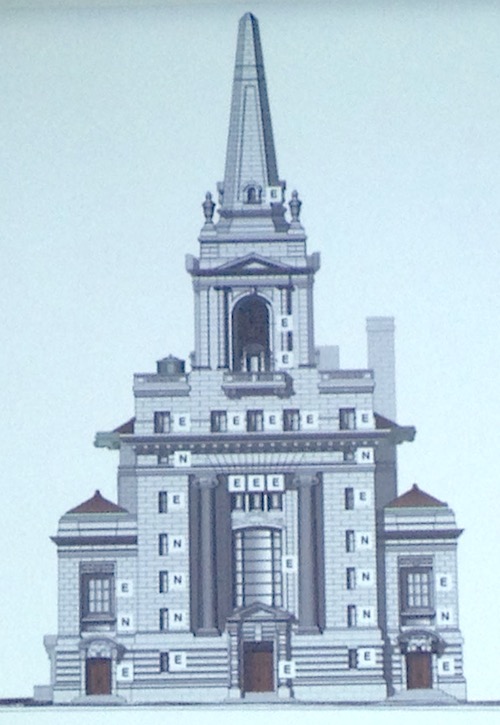
A rendering of the front of the church on 96th street and Central Park West, which developers are trying to turn into condos. More photos at the bottom of this post.
By P.B.
At the end of a three-hour long session at Thursday night’s crowded Community Board 7 meeting, frustration seemed to prevail regarding the proposed changes to the former First Church of Christ on 96th street and Central Park West. Following a detailed presentation by the architects, lengthy questions from the public and an intense debate of the board, the majority of the audience and board members deemed the changes of the building’s exterior as inappropriate to the building’s history and original design.
Situated at the corner of Central Park West and 96th Street, the 111-year-old building was sold by the congregation in 2004, after being landmarked in 1974. The current owner, developer Joseph Brunner, plans to convert the church into 32 apartments, many of which are rather generous in size. The design by Li/Saltzmann and GKV architects proposes 4 one-bedroom units at a generous 1300-1400 square feet, 11 two-bedroom-units ranging from 1200-2600 square feet and 15 three-bedroom-units at 2000-5100 square feet and 2 four-bedroom-units at 3000-5000 square feet. The 32 apartments will include 7 duplex apartments.
Among the most visible changes are the addition of 70 windows to the various façades, the installation of small spikes on the steps in front of the church to prevent homeless people from sleeping there and the adding of two chillers on the building’s roof, rated at 45 dBA (less than a modern dishwasher). The pediment will be raised by 3 feet, 10 inches in order to accommodate the penthouse apartments
The window additions undoubtedly attracted the most attention from both the audience and the board members. Board member Peter Santon described the north façade as “pockmarked” and “like its been shot up by a machine gun”. The north façade with the addition of 42 windows is the one that is least visible from the street, while the façades facing 96th street and Central Park West have fewer windows added. Nonetheless their appearance too is altered significantly.
However, much of the discontent in the audience, largely consisting of long-time residents of the immediate neighborhood, was not only due to the added windows but also because of the proposed replacement of the large stained glass window above the main entrance on Central Park West. Described by Susan Simon, a resident of 370 Central Park West, as “one of the most magnificent sights I could imagine living next to,” there was some contention regarding whether the window is a La Farge original or not. A board member concluded on this issue, to much applause from the audience: “If its by La Farge or somebody else, I don’t care. If the glass is beautiful, it should be preserved.”
Whether or not the stained glass will be replaced by a transparent window ultimately depends on the landmark commission, which will be voting on the building’s design proposal in early December. The community board committee unanimously voted to reject the proposal 6-0-0, (their vote only bears advisory character).
In recent weeks the building has attracted much discontent surrounding the removal of asbestos. Seamus Henchy, the new project manager, joined the project less than a week ago and was unable to comment on the allegations. Instead, he stated that “the ownership is committed to working with qualified workers” and indicated that the contractor would be changed as soon as the current work is concluded. He was unable to provide a timeline.
Councilman Mark Levine said in a statement that the project needs affordable housing, and that the developer needs to use union labor (unions have been protesting the current work, claiming it’s being done by unsafe non-union contractors.).
“The 361 CPW team did make a serious effort to respect the historic nature of the facade and I appreciate their attempt at a thoughtful proposal. But Community Board 7’s Preservation Committee raised valid concerns in their unanimous resolution last night. These must be resolved. In addition, the entire project will be a non-starter for me until the developer commits to using union labor and including affordable housing. I look forward to continuing our conversations and ensuring that the final plan respects the needs of the community.”
Ultimately, one has to wonder if these are going to be particular attractive apartments to live in. Despite the large number of windows that will be added, the developer not meet the light regulations required by New York law and will have to file for a waiver. Even with the religious iconography removed and replaced by the residential iconography of homeless spikes, air conditioning and security cameras – the religious past of the building will hardly disappear. Too strong are the traces left by the original architects Carrière and Hastings: they designed the building as a symbol of unshakeable faith and reverence to a higher power. Dawn Lee, an audience member, described the developer’s attempt to convert the church into a residential building “like trying to fit a camel through an eye of a needle.” The imposing granite exterior will be somewhat broken up, but with the extensive changes proposed the building will obviously be far from your average homey Upper West Side apartment.
The adaptive use of former churches is becoming an increasing reality, as more and more churches across Manhattan are being sold. Many members of the audience were expressing wishes for a non-residential use, but board member Peter Santon acknowledged the profit-driven interest behind the project, asserting that “the developer wants to pack too much floor space into this building.” However, it seems that the alternatives unfortunately are few and far between in today’s real estate market. Board member Mark Diller remarked that the rejection of the proposal by the landmark commission would likely result in a continued “demolition by neglect,” as the building is in dire need of maintenance and restoration, with several leaks in the roof causing increasing water damage throughout the building.
But in a city where people are desperate enough to stick 2000 stickers to lampposts all over the Upper West Side to buy an apartment, living in a former church doesn’t seem so bad anymore. Provided, of course, that you can afford it.
Photos by P.B.



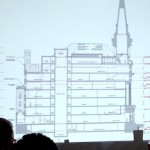
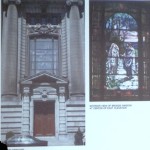
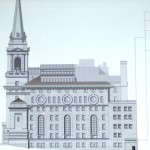
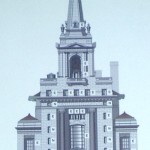




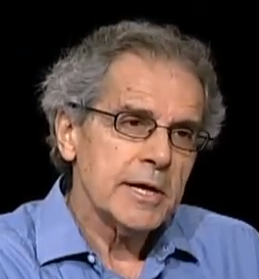
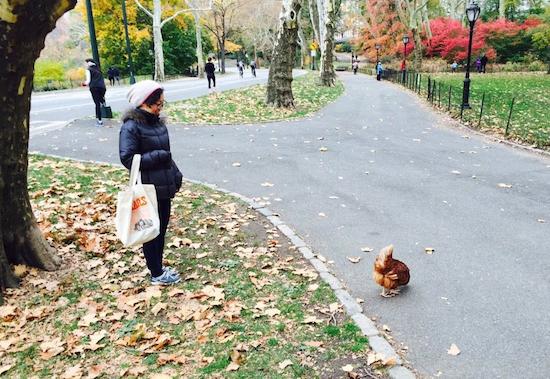
This is an architectural challenge.
Would have been great to stay as a house of worship, but the church decided to sell.
Perhaps a theater or other religious institution (synagogue?) ? would have been nice, but again no one was willing to pay th the price.
LPC and CB work with the developer and try and find a resolution.. Lets just not be roadblocks. Come up with solutions..
The effort to make a 32-40 unit condominium out of this landmarked church with its enormous stature is like trying to fit a square peg into a round hole. The challenge is for New York City LPC to come up with better uses for its landmarks, instead of sitting by idly and letting them be sold to developers who have zero interest in preserving them, and whose self interest is so great, that they cannot even see that this Church will never bend itself to their will. No matter who the architect is.
The stunning and irreplaceable inside of the church has already been demolished. And it is only the exterior with it incredibly important stained glass windows (proposed to be removed), left to claim “landmark status”. Its all now marred by this effort to turn the church with its imposing granite mass, into a bunker with shotgun holes deemed “windows”. What happens with this church will reflect on the Landmarks Commission who’ve shown themselves in recent years to have gone astray from their supposed mission. I fear that this project will reflect very badly on them, if the project is allowed to continue by destroying what has been called by Robert Stern, one of the ten most outstanding churches in New York.
so what is the alternative Grace?
I would love to see this church remain the way it is. But the Church was sold – perhaps the church should have sold it for less but with the promise of remaining intact.
Meanwhile……..the Archidiosee – Catholic Chuch – is closing another bunch of their churches. and they are beautiful inside and out.. most if not all are NOT landmarked and the Archidiosee sells them based on the guidable square feet – as if they are vacant lots!
Lets save those before they are gone too.
Most if not all should be landmarked.
Next on the wreckers ball is Our Lady of Vilnius at the entrance of the Holland tunnel.
I guess a question could be, should a church which is considered to be one of the 10 most outstanding in NYC, be allowed to be sold by a “non-profit”, “non tax-paying” entity to a “for profit” real estate developer? Is there a conflict of interest there to begin with?
When it became known after Crenshaw bought the church, that it was struggling with its heavy debt burden, despite a very large and prosperous congregation,-and many community events for which the church was being rented out-should there not be agencies in place, like the ones which are charged with historic preservation, to bring together public and private funds to preserve such an iconic building-Give it another life which really preserves it, instead of pretending to do so-as a church/synagogue, or community center, symphony space annex, museum. There are many uses that could have been found for this iconic space if that was ever the goal.
This city is far too quick to throw out the baby with the bath water. There are way too many brilliant minds here to find themselves with hands tied to do anything else but try to turn so unsuitable a space into 8 floors of condominiums by stripping away the heart and soul of this sacred place.
Hey- in Pittsburgh, they converted a church into a really cool brewery
https://www.churchbrew.com/
I’m all in on that alternative.
Why must it be Union built?
Unions are campaign donors.